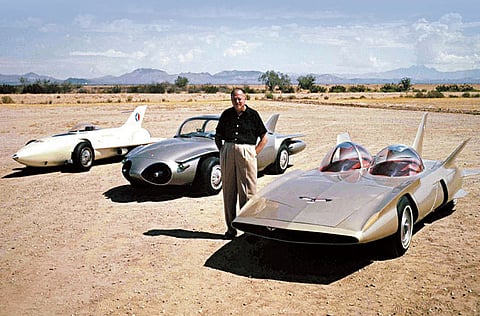Wings of a prayer
Remember the Fifties Cadillacs and Buicks with their enormous tail fins? You have Harley Earl to thank for them.

When you think of cars from around the Twenties, what do you picture? Tall, wobbly and weird looking things, with lights that looked like they were welded on as an afterthought.
Now think of those glorious chrome-laden tailfin Caddies and Buicks of the Fifties, which were a far cry from those boxy monstrosities. Not many know that it was mainly one man who was instrumental in bringing about this incredible transformation of American cars — Harley Earl.
During those early days, the way cars looked was not so important. Making sure they worked was. But when carmakers had solved all their major mechanical headaches, they became interested in trying to use style and looks to help sell cars.
California native Earl, a coachbuilder by trade, arrived on the scene in 1926. He was hired by GM as vice president of its new Art and Colour division. His first move was to change the name to Styling Division. That was just the beginning.
Earl was a man way ahead of his time. He believed cars should look smoother than the dull, boxy appearances they wore back then. You could tell an Earl design from miles away because of his trademark low, long and wide style. This made cars look fast, even if they weren't.
Earl revolutionised the car design process by introducing modelling clay to make full-scale prototypes. This was a cheaper alternative to traditional sheet metal and easier to mould with every design revision.
He came up with the idea of a concept car, called the ‘dream car' then. His first attempt was the Buick Y-Job, which became his daily driver. When you look at it today, it proves just how far-sighted he was. It was a two-seat sports car with hidden headlights, flush door handles, power steering and electric windows. Sound familiar? And remember, this was back in 1938.
After World War II, Earl used his fascination with jet planes to inspire his new creations. He used tailfins — which resembled fighter plane rudders — on Cadillacs in the late Forties.
The fins became standard on many cars in the Fifties. The style caught on throughout Detroit and eventually led to competition between Earl and Chrysler's Virgil Exner over the size and complexity of tailfins, culminating in those on the 1959 Cadillac.
Coupled with his other innovations such as two-tone paint schemes and the one-piece wrap-around windshield, American cars of the Fifties were some of the best looking of the time.
He also green-lighted the Project Opel concept, which was eventually offered to the public as the Chevrolet Corvette in 1953.
After three decades with GM, he retired in 1958 and Bill Mitchell took over the reigns and subsequently, the tailfins and cars in general became smaller.
Earl suffered a stroke and died in 1969 but he will always be remembered as the originator of clay modelling of car designs, the wrap-around windshield, two-tone paint and those stunning tailfins.
Best of all, he will always be remembered as the man who changed the shape of the American car.
Facts
Name Harley Earl
Born November 22, 1893
Hollywood, California, US
Died April 10, 1969 (aged 75)
Best known for Buick Y-Job, Project Opel and massive pink Cadillacs with fins
Sign up for the Daily Briefing
Get the latest news and updates straight to your inbox


